

Tips For Increasing Student Focus: Tracking. Student Participation Strategy: Talk Moves. 10 Top-Notch Strategies To Boost Student Participation And Active Learning. Every teacher strives for an active classroom buzzing with engaged and eager students.
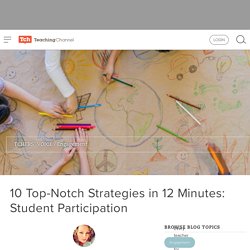
However, even the most experienced teachers face days when it seems like they’re the only one talking and the students have simply tuned out. 10 Top-Notch Strategies To Boost Student Participation And Active Learning. 10 Top-Notch Strategies To Boost Student Participation And Active Learning. Boosting Engagement With Notices and Wonders. Encouraging Academic Conversations With Talk Moves. Scaffolding Discussion Skills With a Socratic Circle. How to move your lessons from good to outstanding. Where would I be without Twitter?
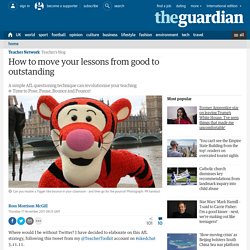
I have decided to elaborate on this AfL strategy, following this tweet from my @TeacherToolkit account on #ukedchat 3.11.11. My tweet said "#ukedchat Missed out tonight, look forward to reading ideas. My favourite T&L strategy at the moment is "Pose, Pause...Pounce, Bounce" #AfL". Firstly, this concept is not mine. So it is at this point, where I will be honourable and credit a colleague who I think has a money-spinning idea here. The fabulous Mrs Pam Fearnley delivered the session. What is it? It is a simple, yet sophisticated, AfL (Assessment for Learning) questioning technique to help teachers move from good-to-outstanding.
Why is it useful? For many reasons. The strategy encouraged teachers to take risks and tease out the "learning" in class. How does it work? I have listed the four-part approach below with additional information that I hope explains the method. . • Give the context of your approach to the class. This is the hard part. Explore! To Learn, Students Need to DO Something.
7 Ways to Spark Engagement. Student engagement is the Mega Millions of education: When you hear about it, it seems so easy to win—and then you read about the odds. The good news is that there are effective strategies for boosting student engagement, and they’re considerably more likely to pay off than playing the lottery. A growing body of research in education and the social sciences suggests that students’ curiosity can be stimulated in ways that strengthen their connectedness to lessons, interactions with each other, and willingness to commit to learning goals. There are simple techniques that teachers can use during a lesson to boost curiosity, and thus engagement, among students—especially older ones, who are at greater risk for losing interest. Boosting Student Engagement 1. Try posing a broad question to groups of three or four students, such as: “What would happen if a butterfly’s habitat was suffering a severe drought during the pupa stage?” 2. Common Opportunities to Build Rigor: Means of Participation.
Great teachers are always seeking to make their classrooms as rigorous as possible.

Over the next three days, I’ll be sharing thoughts about three ‘common opportunities’ –things I see in place when I observe great classrooms that can often make a big difference—quickly—in good ones. Common Opportunity #1: Improve the rigor of your classrooms by defining the means of participation you want, every time you ask a question. A Mysterious But Powerful Way To Improve Listening. We’ve covered the topic of speaking so students will listen extensively here at SCM.
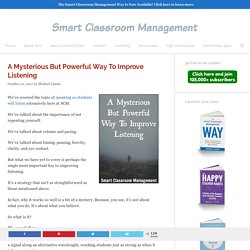
We’ve talked about the importance of not repeating yourself. We’ve talked about volume and pacing. We’ve talked about timing, pausing, brevity, clarity, and eye contact. But what we have yet to cover is perhaps the single most important key to improving listening. It’s a strategy that isn’t as straightforward as those mentioned above. In fact, why it works so well is a bit of a mystery.
How To Avoid Losing Your Students' Attention. There is a phenomenon I see again and again in the classrooms I visit.
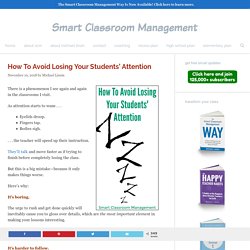
As attention starts to wane . . . Eyelids droop.Fingers tap.Bodies sigh. The Key to Unlocking Student Engagement. Engagement means something different to just about everyone.
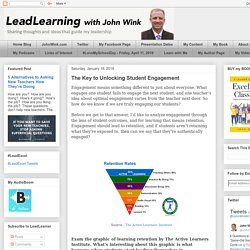
What engages one student fails to engage the next student, and one teacher’s idea about optimal engagement varies from the teacher next door. So how do we know if we are truly engaging our students? Before we get to that answer, I’d like to analyze engagement through the lens of student outcomes, and for learning that means retention. Engagement should lead to retention, and if students aren’t retaining what they’re exposed to, then can we say that they’re authentically engaged? Exam the graphic of learning retention by The Active Learners Institute. 9 Strategies for Encouraging More Students to Talk in Class. While it is possible to learn by listening, I’ve found that oral participation leads to greater gains in student literacy and engagement.
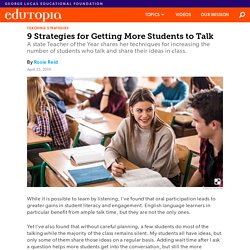
English language learners in particular benefit from ample talk time, but they are not the only ones. Yet I’ve also found that without careful planning, a few students do most of the talking while the majority of the class remains silent. My students all have ideas, but only some of them share those ideas on a regular basis. Adding wait time after I ask a question helps more students get into the conversation, but still the more confident students are more likely to raise their hands. Edutopia. I’ve enjoyed creating and sharing brain breaks and focused attention practices here over the past few years—practices that benefit every student as their brains prepare to learn. Brain breaks create a state of relaxed alertness, while focused attention practices help students slow down and focus on a stimulus, enhancing their executive functions of sustained attention and emotional regulation. These practices address discipline proactively, before any problems arise. 9 Strategies for Encouraging More Students to Talk in Class.
9 Strategies for Encouraging More Students to Talk in Class. 5 Movement Strategies That Get Students Thinking. Read Too Much Sitting?
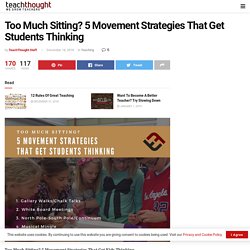
5 Movement Strategies That Get Kids Thinking contributed by Kenny McKee Each day more research confirms the link between movement and learning. Brain researcher David Sousa claims that physical activity increases the amount of oxygen in our blood, and this oxygen is related to enhanced learning and memory. However, many secondary teachers struggle to integrate movement into the classroom. Energy and Calm: Brain Breaks and Focused-Attention Practices.
When presented with new material, standards, and complicated topics, we need to be focused and calm as we approach our assignments.
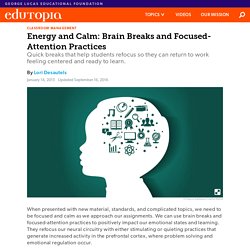
We can use brain breaks and focused-attention practices to positively impact our emotional states and learning. They refocus our neural circuitry with either stimulating or quieting practices that generate increased activity in the prefrontal cortex, where problem solving and emotional regulation occur. Brain Breaks A brain break is a short period of time when we change up the dull routine of incoming information that arrives via predictable, tedious, well-worn roadways. Our brains are wired for novelty. When we take a brain break, it refreshes our thinking and helps us discover another solution to a problem or see a situation through a different lens.
The Junk Bag: I always carry a bag of household objects containing markers, scrap paper, and anything that one would find in a junk drawer—for example, a can opener or a pair of shoelaces. School Engagement Is More Than Just Talk. It's rare for an educator to make it through an entire day without hearing the word "engagement.
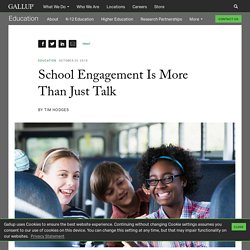
" We want our students, teachers, parents and the entire school community to be engaged. But what does that really mean? 7 Ways to Spark Engagement.